My baby son loves his baby carrier and has reliably taken many, many on-the-go naps in it. So it was a no-brainer for us to want to wear him in his carrier through the airport and on our flights. However, I wondered what the rules where for bringing it through security and on board the plane, and quickly learned over the course of 13+ flights that there are certain specific rules and regulations around baby carriers (and baby wraps).
Please read these rules carefully to avoid the frustrations with baby wearing that my husband and I experienced on some of our flights!
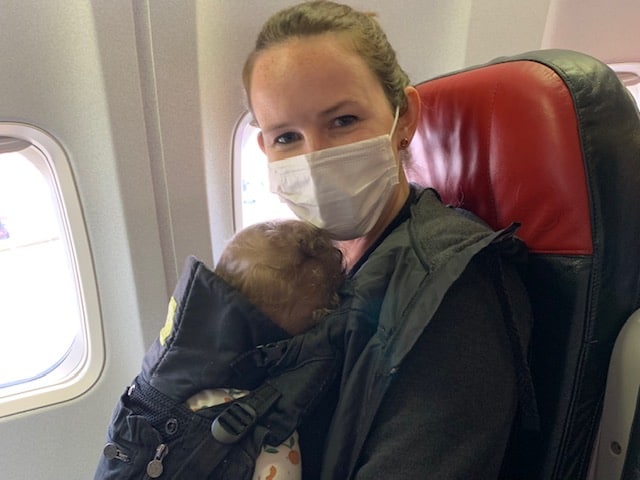
Are baby carriers allowed on airplanes?
You’re allowed to bring your baby onto the plane in a baby carrier (or wrap) and you can put them in their carrier during the flight. However, you’re required to remove babies from their baby carrier (or wrap) during takeoff and landing and hold them on your lap until the seat belt sign is turned off.
During takeoff and landing, you can keep your baby carrier in the overhead bin or in the space under the seat in front of you. We’ve always kept our carrier handy during flights because our baby sleeps in it when we’re out and about, including on the airplane. He absolutely loves it and I can’t imagine traveling without it.
Not only is it essential for naps but having your hands free while navigating the airport with all of your other bags and important items is key (especially if flying solo with your baby). I would also highly recommend wearing pants with pockets or a fanny pack, for easy access to your wallet, passport, phone, etc.
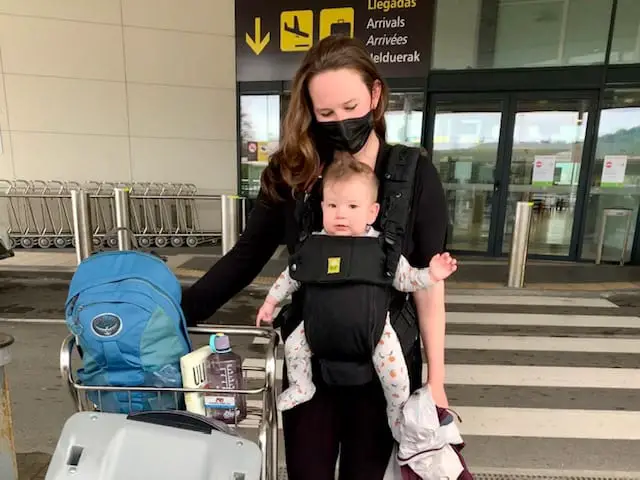
Sometimes I don’t even take my baby carrier off for the entire flight, especially when flying alone or on shorter flights. I take my son out of it, but continue to wear it so that I don’t have to fuss with putting it away during takeoff and then try to get it back on again afterward while keeping an eye on a squirmy baby.
Once you’re in the air and the seat belt sign is turned off, you’re allowed to put your baby back in their carrier or wrap, and walk around the aisles if you want to. This is how we’ve reliably gotten our son to sleep on most of our flights with him so far. We use the Lillebaby carrier and loved the Boba wrap when he was smaller (from about 0-5 months) but there are many great models out there.
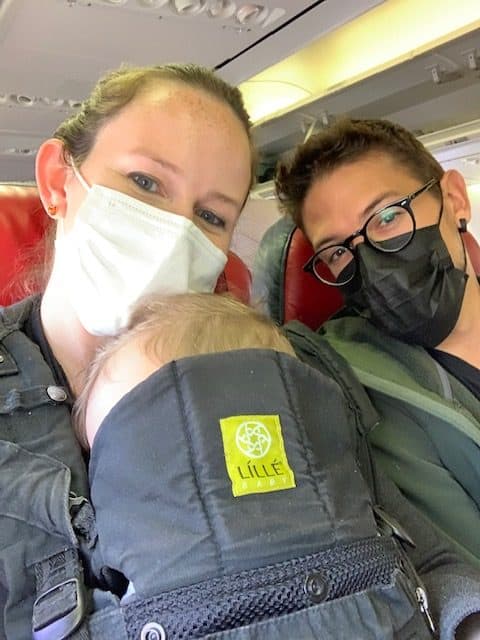
Can I wear a baby during takeoff and landing?
You cannot wear a baby during takeoff and landing due to safety precautions. You are required to remove your baby from your carrier or wrap and place them on your lap.
In North America, flight attendants will ask you to hold your baby facing toward you during takeoff and landing. In Europe, they will give you a baby seat belt extension, which loops around your seat belt and then around the baby. They will ask you to face the baby forward. Regulations vary from place to place and even airline to airline, so just be ready to be a bit flexible.
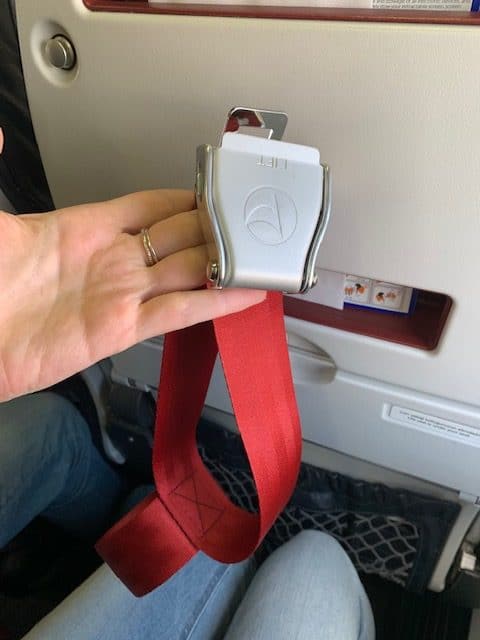
Remember that regardless of whether your baby is sleeping, you will have to remove them from their carrier or wrap during takeoff/landing. So if you’re able to plan your baby’s schedule, try to keep them from sleeping until after takeoff so that they won’t be disrupted.
Unfortunately, I’ve had the unpleasant experience of having to wake my baby up from a nap to take him out of his carrier for takeoff and landing. In my experience, most flight attendants are quite adamant about this rule as it’s for the safety of the baby.
Can babies sleep in carriers on airplanes?
You’re allowed to put your baby in their carrier or wrap during the flight for them to sleep. It’s only during takeoff and landing that you can’t have your baby in their carrier. Unfortunately, even if they are fast asleep, they will need to be taken out of their carrier for takeoff and landing.
Because my baby is a contact sleeper, it’s great news that we can bring our carrier onboard for his naps, but the takeoff and landing rules really do require a bit of planning to try and avoid a cranky baby. If at all possible, you may want to arrange their sleep schedule to be something like this:
- Nap in the car on the way to the airport
- Awake for check-in and security
- Awake at the gate to burn off some energy (mainly for older babies)
- Awake but sleepy while boarding and takeoff
- Nap once in the air and (hopefully) for a good chunk of the flight
- Awake for landing and deplaning
If your baby also sleeps well in their car seat, you might consider that an option. Some airlines will let you bring your car seat onboard for free for your lap baby, as long as there are empty seats available. Be sure to call your airline and ask, or ask at check-in. If you really want the option of having your car seat, consider buying a seat for your baby.
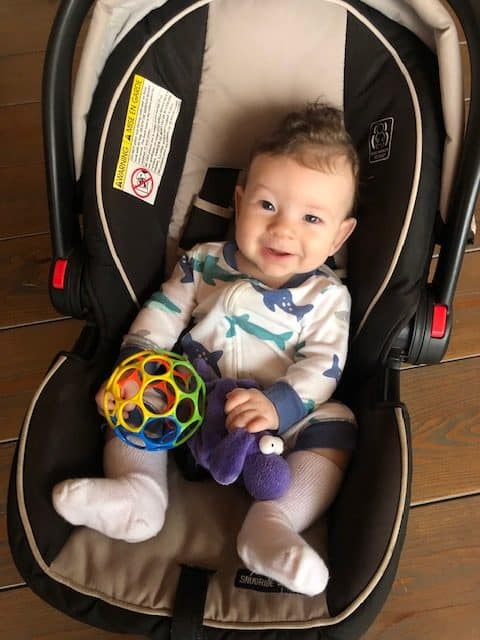
Another option for putting your baby to sleep on the airplane if you’re taking a long haul flight is to ask to be placed in the bulkhead row (at the front of the plane or at the front of economy seating), where you can request a baby bassinet at the gate.
My friend used this option for a transatlantic flight with her baby and she said it worked well. Even if your baby doesn’t sleep in it, you’ll be able to rest your arms. You can read all the pros and cons of bulkhead seating (and window seats vs. aisle seats with babies) here.
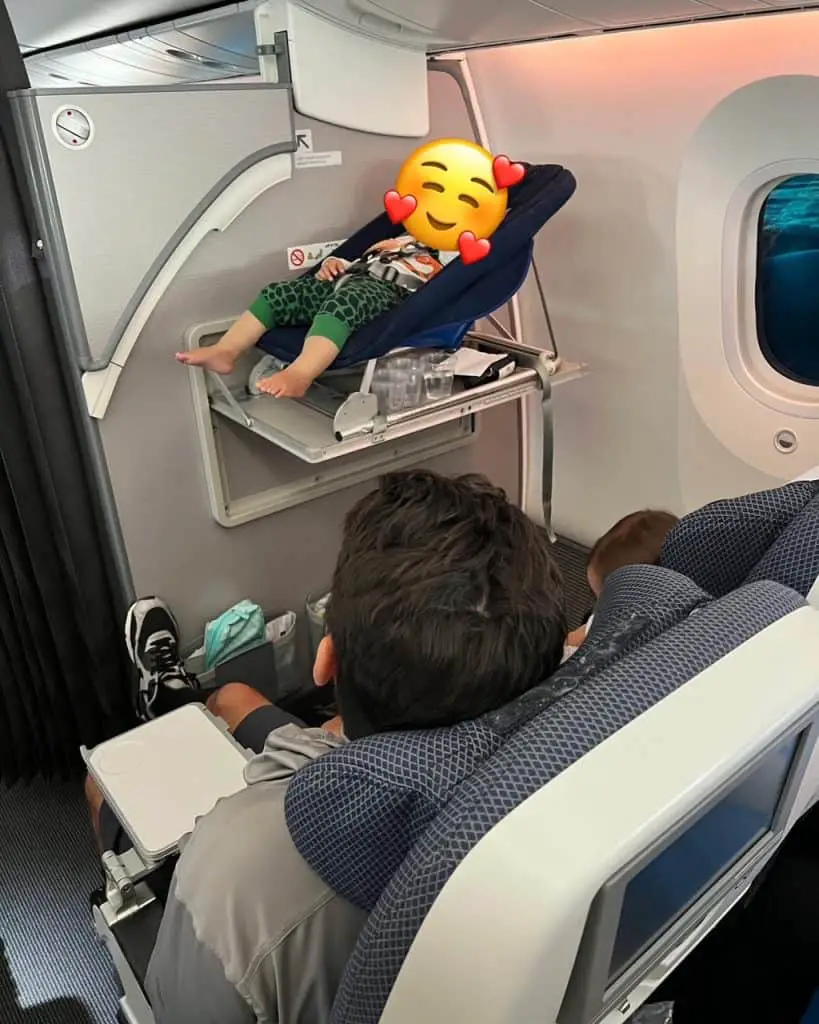
How do you hold a baby during takeoff?
For a North American flight: A lap baby should be held, facing-in, by a seated adult. The seat belt should be worn snuggly over the adult’s lap and NOT placed over the baby.
I found this to be pretty straightforward and easy enough to do with a younger baby. My son has always liked being held against us like this anyway. I’m a bit worried about having to hold my son like this now that he’s an older baby/toddler (we have a long flight coming up just next week). The wiggle factor is significantly higher now at 13 months. But these are the rules!
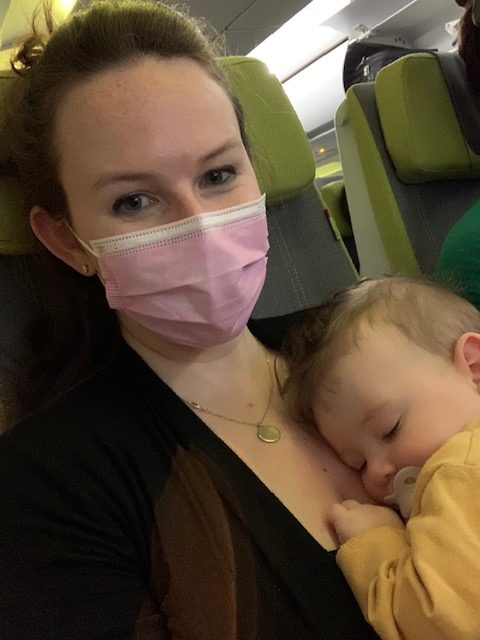
For a European flight: A lap baby should be held, facing forward, on a seated adult’s lap and secured with an infant seat belt. The infant seat belt is looped onto the adult seat belt and then buckled across the baby’s lap.
I wasn’t crazy about this scenario when I first had to do it. Especially once my son got a bit older. It wasn’t too bad at about 6 months on our flights to Barcelona but by the time he was 8/9 months old, he was much more wiggly and keeping him seated with a seat belt around his waist, facing forward, was a bit of a challenge. We busted out some dollar store toys (and the airplane safety information card) to try and distract him as much as possible.
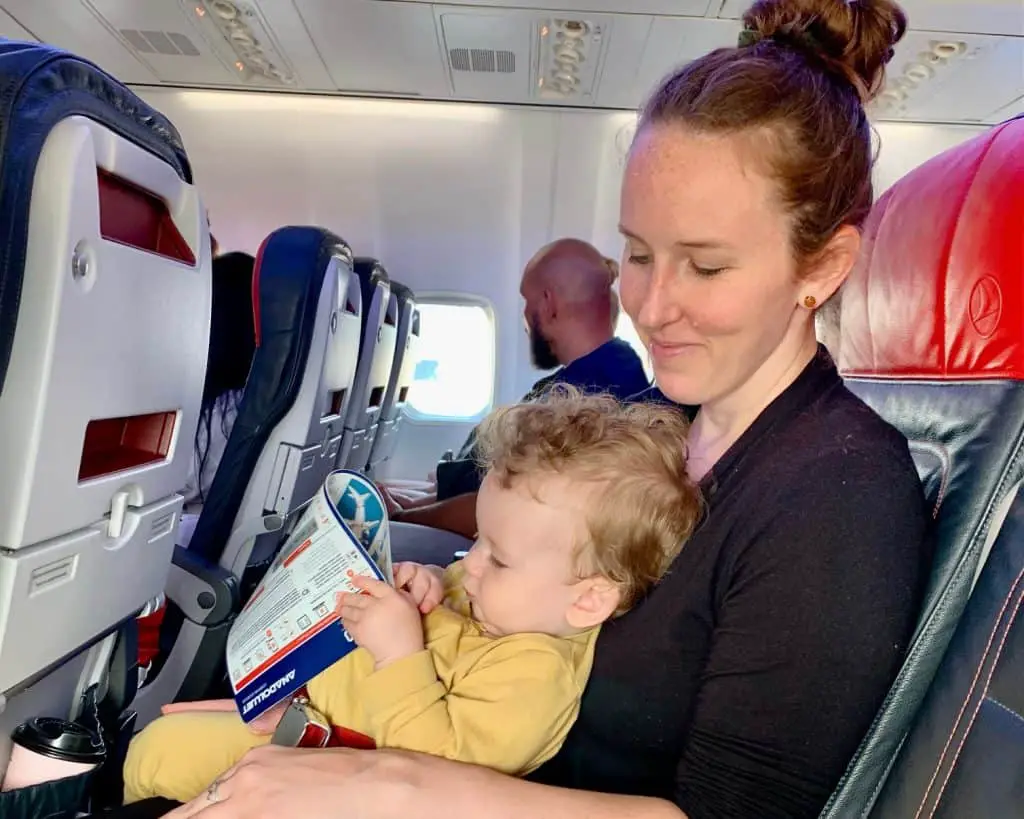

Do you have to remove your baby from the carrier at security?
| American airport security (TSA) | Canadian airport security | European airport security |
| No | Yes | Yes |
In theory, these are the rules according to the American and Canadian airport security websites. Unfortunately, when I went to take some of my flights with my son in the U.S., what I read on the security websites did not match my actual experience.
The same was true for other experienced traveling mothers I’ve spoken to in Facebook groups. It seems that in the U.S., the TSA agents sometimes aren’t familiar with their own rules regarding parents and babies/toddlers.
Officially, the TSA website states:
Infants may be carried in a sling/carrier (to include lap baby) through the walk-through metal detector or when being screened in a wheelchair, but may be subject to additional screening
But in a survey of over 100 mothers in a traveling babies and toddlers Facebook group that I am a part of, many of them said that they have been asked to remove their babies from their carriers when going through security. The same thing has happened to me.
It seems that it depends on the agent and the airport as to what actually happens when you go through security. I was very surprised that more than one mom said that it didn’t even matter that they had TSA pre-check, which is supposed to speed up the security process:
I have TSA pre-check and global entry, they’ve let me carry my baby through only once, all other times I had to hand baby over and walk through alone. They let me wear an empty carrier once, the rest of the times I had to take it off and put through X-ray. I stopped bothering with it and kept it in a bag until after security and then put it on. I don’t think they have definitive rules on this and each TSA person is different.
However, another mom had the complete opposite experience (in a positive way), as she said:
I’ve walked through airport metal detectors literally hundreds of times with babies attached. I’ve never once been asked in the US to remove them!
So there is hope! And another mom mentioned that it was fine to keep her baby in the carrier, but the procedure was slightly different:
I have always worn [my baby carrier] through airport security with my daughter in it. I’ve never had to take her out of it, they have me walk through a different scanner than everyone else though, and have swabbed my wrists.
Fortunately, TSA has a Facebook messenger account and they will respond to your questions. So, you can actually get clarifications on their policies and take screenshots of their replies to show the TSA agents at the airport (should you have any issues).
If you plan to keep your baby in your baby carrier going through security and a TSA agent asks you to take them out, you can show them this screenshot:
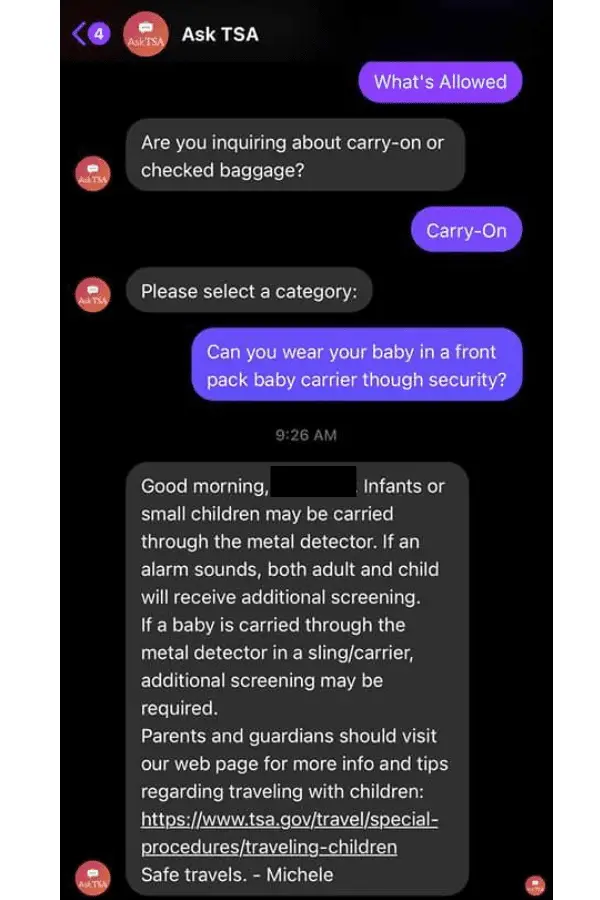
Be prepared to take your baby out of the carrier in Canada and Europe
In the U.S., it seems that it could possibly go either way and you may not have to remove your baby from their carrier. However, in Canada and Europe, be prepared to take them out. The Canadian airport security website explicitly states to: “Remove infants from their strollers/carriers. Hold them in your arms and proceed through the metal detector.”
And personally, I have had to remove my baby son from his carrier on all of our European flights — even when I was flying alone, which I thought would be bit tricky with all of our stuff. However, I’ve been very lucky to have the nicest security agents in places like Spain and Turkey who helped me out so much.
One security agent woman in Spain held my baby for me while I reorganized all my bags on the other side of the security line. It’s also really helpful at the Barcelona airport that they have these awesome baby-friendly playpen areas (pictured below) set up right after the security line. How genius is that? You can place your baby in them as you’re dealing with all your bags, shoes, etc.!
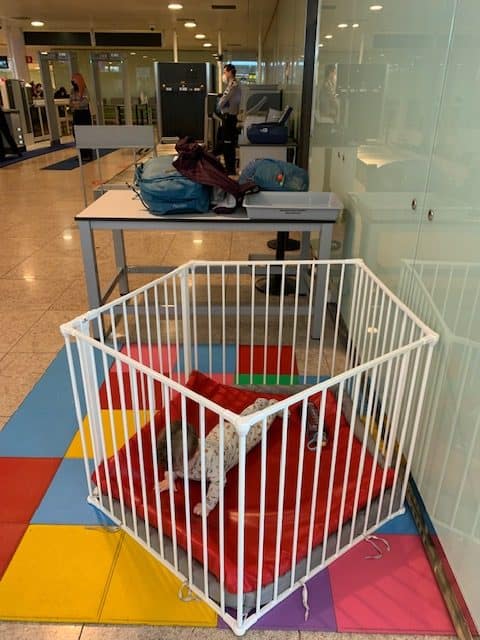
I hope this helps you out on your next flight! These articles (below) may also help to answer some of your lingering flying with baby/toddler questions. Best of luck 🙂
